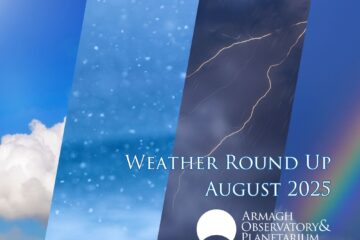Recent observations of the helium star HD144941 have been obtained from space. Armagh astronomers Professor Simon Jeffery and Dr Gavin Ramsay have discovered that they show a light curve best explained by darker and lighter patches on the star’s surface coming into view as the star rotates with a period about 14 days. The puzzle is that helium stars like HD144941 shouldn’t have spots.
Simon Jeffery has been interested in a group of rare stars known as helium stars for over 30 years, and made his first observations of HD144941 in 1983 using small telescopes in South Africa. Much to his disappointment, HD144941 showed no sign of being variable. With the instruments available then, it showed no changes larger than between 2 and 5 parts per thousand.
At the same time, Jeffery was measuring the pulsations and surface chemistry of a related helium star called V652 Herculis. This amazing star changes in brightness by about 10% every 2.5 hours. At the same time, its surface pulsates up and down at speeds of up to 35 kilometres per second in each direction. Its surface shows a chemistry produced from the synthesis of hydrogen into helium by nuclear reactions deep inside a star … which is now exposed.
Some years later Jeffery realised that while V652 Her is rich in metals, HD144941 has only 1% of the metals that the Sun has. It is metals like iron and nickel that drive pulsations in such stars … so the absence of these metals could explain the lack of pulsations … and therefore HD144941 should not vary.

Fig 1: The K2 light-curve of HD144941. The x-axis shows time in days after Modified Julian Day number 56893, and the y-axis shows the difference in light relative to the mean in parts per thousand (so +1 represents an increase in brightness of 0.1 per cent). Credit: Jeffery & Ramsay 2018 MNRAS in press.
Thirty years later, and HD144941 has come under scrutiny again. By good fortune it is the only helium star to lie in one of the fields to be observed by K2, the re-purposed Kepler spacecraft.
K2 observed HD144941 in 2014. Jeffery and Ramsay discovered the data by accident when looking for other information about the star, and were surprised by the light curve (Fig. 1). Noticing that alternate peaks were more similar than consecutive peaks, they identified a double-wave light curve with a period of about 14 days. Folding the light curve on this period allows the structure to be seen in more detail (Fig. 2). Since the period is too long, and the light curve shape to complicated, the variations cannot be due to pulsations. The startling conclusion is that there must be darker and lighter patches (or spots) on the surface of the star, and that these appear and disappear from view as the star rotates. There must be at least two darker spots on roughly opposite sides of the star, with slightly different shapes, in order to explain the light curve.

Fig 2: The K2 light-curve of HD144941 folded on a period of 13.93 days (black dots) and smoother (red symbols with error bars) in order to illustrate the detailed structure of the double-wave light curve. Credit: Jeffery & Ramsay 2018 MNRAS in press.
The real problem is to explain the spots, which are not normally seen in stars as hot as HD144941. One possibility is an inclined magnetic field, several hundred times stronger than the Earth’s magnetic field, which might concentrate selected chemicals at the magnetic poles, making them darker than the surrounding surface (Fig. 5). Or maybe chemical spots can arise without a magnetic field. A very strong magnetic field has been measured on the remarkable helium-strong star sigma Orionis E, but that is a young massive main-sequence star. HD 144941 appears to be an old low-mass metal-poor star from a completely different history. This is the first time we have seen direct evidence for spots on such a star. Some very careful observations will be needed to find an explanation.

Fig 3: Kepler is a space observatory launched by NASA on March 7, 2009 to discover Earth-size planets orbiting other stars. Originally designed to stare at a fixed region in our Milky Way, Kepler’s sole scientific instrument is a photometer that could continually monitor the brightness of over 145,000 main sequence stars in a fixed field of view. After a second reaction wheel failed in 2013, the observatory was given a new mission to stare at selected patches of sky for three months at a time, and in each patch collecting light from over 100,000 stars with a precision better than a few parts per million. Still looking for short-period planets, the prospect of finding Earth-size planets was reduced, so the mission controllers encouraged the study other types of variable star. To distinguish the new science goals, they gave the mission a new name, K2. Credit: NASA

Fig 4: The Kepler/K2 camera is approximately 30 cm x 30 cm and is composed of 21 sensitive science modules (or 42 individual charge-coupled devices) as well as four corner modules used for fine guiding. Credit: NASA Ames

Fig 5: The Stibbs oblique rotator model in which two magnetic poles are offset from the rotation axis. Dark spots at the magnetic poles will appear to dim the star two times during each rotation. Credit: Jeffery 2018
Article written by: Simon Jeffery, Research Astronomer at Armagh Observatory and Planetarium




1 Comment
K2 spots a rotating Helium Star – MeasurementDataBases for Industry & Science · February 1, 2018 at 15:58
[…] Astronotes Astronotes: Recent observations of the helium star HD144941 have been obtained from space. Armagh […]